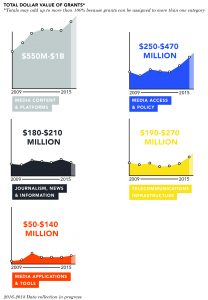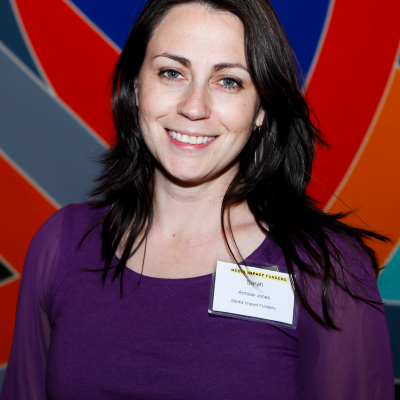
The global media funding ecosystem has evolved dramatically over the last 20 years, largely in response to tectonic shifts in how people around the world consume, produce and share information. Revolutions in information and communication technologies have enabled the rise of new platforms that are competing with legacy media and threatening the business models of established media institutions. Around the globe, philanthropy plays a crucial role in supporting a variety of diverse media-related initiatives, including strengthening media institutions, improving democratic processes, raising awareness and advocacy through public service radio campaigns addressing health issues, ensuring equitable access to communication technologies, and protecting freedom of expression.
While the funding landscape for U.S.-based philanthropies investing in media is well-documented, thanks to reporting requirements and tools such as Foundation Maps for Media Funding, (referred to below as the “media data map”), the picture for international philanthropy is far less clear.
It is imperative that the philanthropic community collectively seek to better understand how the media funding landscape is being shaped by a variety of actors and stakeholders around the world. Improving the mechanisms for capturing and analyzing global media funding trends is not only relevant for foundations focused on traditional media issues such as freedom of expression and journalism support, but also for donors working on healthcare, economic security, environmental issues and human rights. As the reach of media extends, it impacts all issues and areas of philanthropic giving.
With support from the Bill & Melinda Gates Foundation, Media Impact Funders has been researching worldwide trends, challenges and opportunities for media funding. The research in this report—Global Media Philanthropy: What Funders Need to Know About Data, Trends and Pressing Issues Facing the Field—draws on a variety of sources: data from the media data map through 2015, results from a survey of leading organizations engaged in funding media-related projects around the world, analyses of existing literature and reports, and insights offered by experts across a range of media funding issues.

Key data highlights:
- Between 2009 and 2015, according to a November search of the media data map, $9.9 billion in media grants were made worldwide.
- Of that, $7.7 billion was awarded to U.S.-based organizations (a number of which work on international projects from U.S. headquarters).
- $8.8 billion was made by U.S.-based funders.
- In 2009, $915 million in media grants were made by funders around the world, jumping to $1.9 billion in 2015.
- In 2009, 9,230 media grants were made to global recipient organizations jumping to 47,928 media grants in 2015.
- In 2009, grants related to Media Content and Platforms totaled approximately $550 million and in 2015, the same category shows $1 billion in grants.
Funder survey:
To better understand how global media funders are currently thinking about their grantmaking strategies as well as how the wider media philanthropy space is evolving, in the spring of 2018, Media Impact Funders sent out a short survey to a group of media funders engaged in global grantmaking. In the surveys, we asked about programmatic and geographic priorities; whether media grants were given from specific portfolios; types of support given; and key issues influencing global media grantmaking.
Highlights from the funder survey:
- Media funding is not limited to specific philanthropic portfolios. Investments come from a variety of
sources within organizations, from dedicated journalism programs to media projects classified under a diverse range of portfolios including freedom of expression, economic justice and freedom from violence. - The main challenges identified by those surveyed include:
-
- Local laws that inhibit donor support for civil society grants;
- Feelings that implementation of democracy-oriented projects can endanger local grantees;
- Scaling appropriately (from larger to smaller grants) to meet local organizations’ needs;
- Supporting viable media business models;
- Finding appropriate partners with the capacity to administer grants programmatically and financially.
-
 A similar survey was also sent to intermediaries, implementation organizations, and media associations that are engaged in research and network-building for the media development sector. These organizations play a significant role in setting global media funding priorities and coordinating with both donor organizations and recipient organizations around the world and are often more connected to local partners working on the ground.
A similar survey was also sent to intermediaries, implementation organizations, and media associations that are engaged in research and network-building for the media development sector. These organizations play a significant role in setting global media funding priorities and coordinating with both donor organizations and recipient organizations around the world and are often more connected to local partners working on the ground.
Highlights from intermediary organization survey:
- Security is a significant concern.
- Long-term funding is rare and needed to support sustainable media systems.
- Funding for civic life (e.g. informing the public, holding government accountable, civic systems, etc.) is a primary type of funding made by intermediaries and implementation organizations that responded. These organizations also fund content around particular issues or advocacy campaigns.
- Freedom of expression and programs with an emphasis on web-based media are larger priorities for intermediaries and implementation organizations.
Insights from the field:
With so many pressing issues affecting the media funding space as well as specific regional considerations around grantmaking strategies and priorities, Media Impact Funders turned to experts from the field and asked them to share insights across a range of media issues. Listening to those working on the ground is essential for understanding challenges and opportunities in a global context and these essays offer critical insights that funders need to understand in the global media ecosystem. Topics include current challenges facing African and Indian media ecosystems, along with suggestions for solutions; the need for greater collaboration, experimentation and media development coalition-building to withstand political and social upheaval; the need for greater security awareness and support by funders; and the new ways of thinking about public media.
Conclusions:
Both funding and making media are now dangerous in new ways: Foundations, publishers, editors and journalists across the world are facing not just familiar forms of repression and censorship, but new threats from breaches to digital privacy and a notably uncivil online culture. Funders need to work more systematically to educate and protect themselves and their grantees.
Power dynamics are skewed in favor of American funders: The data emphasizes U.S.-based funders, who appear to be setting the agenda for foundation support of media worldwide, raising questions about power dynamics between these funders and local foundations and grantees. Improving worldwide data collection and access will help all funders understand how non-local funders’ priorities match, complement or possibly undermine funders and NGOs in local communities. In addition, supporting local media efforts, business model development and listening to grantees and implementation organizations are key to adjusting the balance of power. As our survey indicates, funders and those on the ground are not always concerned about the same things, and better understanding of local needs is essential for a stronger media ecosystem and improved outcomes for all the issues funders care about.
Foundations can have an outsized influence on a country’s media system: This power can be productive or disruptive depending on the context. On the one hand, funders can support convenings, monitoring, regional partnerships and even media distribution from outside of countries where anti-democratic leaders repress the media. On the other, foundations can create perverse incentives through supporting initiatives that don’t match needs on the ground, or through short-term funding that leaves local organizations stranded.
The moment is ripe for organizing media funders in creative and effective new ways: There are areas for research and sharing of best practices that are relevant in many countries and bear further examination. These include the role that social media plays in public discourse, new business models for news, impact evaluation for public interest media investments, and the need to make a stronger case for media as a legitimate area for philanthropic support. These topics could serve as organizing principles for enlarging and engaging a larger network of global media funders. There are also new ways for funders to work together, in multi-stakeholder coalitions, and even in partnership with grantees. The funding environment differs widely from country to country, so it’s important not to seek one-size-fits-all solutions.
Funders need to see the bigger picture: Funders need to understand and support media and media ecosystems in order to advance their work and improve society. New funding approaches and sources highlight the need for gathering and analyzing data about global media funding, and understanding how it fits into the overall global funding picture.
Better data is needed: Our research and literature review highlighted the significant barriers the field faces in truly understanding the reach and scope of global media philanthropy. Developing reliable frameworks of philanthropic data collection will be imperative to understanding how funders are working around the world, as well as the trends, challenges and opportunities. It also highlighted the need for U.S.- and European- based funders to more thoughtfully report grant information, to ensure improved coding accuracy, as well as more nuance around purpose and populations served.

